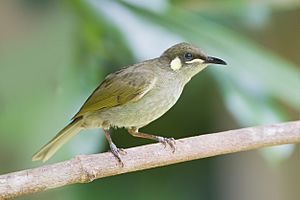Yellow-spotted honeyeater facts for kids
Quick facts for kids Yellow-spotted honeyeater |
|
|---|---|
 |
|
| Conservation status | |
| Scientific classification | |
| Genus: |
Meliphaga
|
| Species: |
notata
|
The yellow-spotted honeyeater (Meliphaga notata) is a type of bird. It belongs to the honeyeater family (Meliphagidae). This bird is sometimes called the lesser lewin. You can only find it in northern Queensland, Australia. Its name comes from the bright yellow spot behind its eyes.
This honeyeater is mostly olive, brown, and gray. It weighs about 23 to 30 grams. Its wings can spread about 8 to 9 centimeters wide. There are two main types, or subspecies, of this bird. They are called Meliphaga notata notata and Meliphaga notata mixta. Yellow-spotted honeyeaters are known for being quite active. They also have a loud, metallic call.
Contents
What is a Yellow-Spotted Honeyeater?
The yellow-spotted honeyeater is a small bird. It is part of a large group of birds called Passeriformes. This group includes many common songbirds. It also belongs to the honeyeater family.
Scientists have identified two subspecies of this bird. One is Meliphaga notata notata, described in 1867. The other is Meliphaga notata mixta, described in 1912. The name notata comes from a Latin word. It means 'spotted' or 'marked', referring to its yellow spot.
What Does the Yellow-Spotted Honeyeater Look Like?
This bird has an olive-brown color on its back. Its belly is olive-gray. But its head has brighter yellow areas. The bird's legs, feet, and eyes are brown. Its beak is also brown. It measures about 16 to 20 centimetres (6.3 to 7.9 in) long.
Male yellow-spotted honeyeaters usually weigh between 24 and 29.5 grams. Females are a bit lighter, weighing from 23.5 to 30 grams.
The average wingspan for males is about 8.6 to 9.1 centimetres (3.4 to 3.6 in). For females, it is about 7.9 to 8.3 centimetres (3.1 to 3.3 in). These measurements can vary slightly between the two subspecies.
Where Do Yellow-Spotted Honeyeaters Live?
These birds mostly live in the tropical rainforests. You can find them in northeastern Australia. Their home stretches from Mackay up to the northern Cape York Peninsula. Long ago, in 1901, some people thought they also lived in New Guinea.
Yellow-spotted honeyeaters usually live in higher places. They prefer areas at 200 metres (660 ft) or more above sea level. They have been seen as high as 1,200 metres (3,900 ft). However, they are not often found above 500 metres (1,600 ft).
Even though they love forests, they sometimes visit suburbs. This happens if the suburbs have enough trees. They have even been seen in some cities. This is when local plants are used for landscaping. They live in both open forests and forests with lots of shrubs. The yellow-spotted honeyeater often shares its home with the graceful honeyeater.
How Many Yellow-Spotted Honeyeaters Are There?
The yellow-spotted honeyeater is listed as "Least Concern" by the IUCN Red List. This means there are many of them. Their total population seems to be steady. The area where they live is very large. It covers over 110,000 square kilometers.
What Do Yellow-Spotted Honeyeaters Do?
The call of this bird is very unique. It sounds metallic and high-pitched. Some describe it as a "rattling song." It has four to five "ee-yeu" sounds repeated. Others say it sounds like a "machine gun rattle."
These birds eat different things. They enjoy insects, sweet nectar from flowers, and fruit. When they sit on a branch, their body is often held almost flat.
Yellow-spotted honeyeaters are known to be loud. They can also be a bit aggressive. They usually live alone. Sometimes, you might see them in pairs. Very rarely, they form small groups of a few birds. They do not migrate, meaning they stay in the same area all year.
Reproduction and Life Cycle
The nest of a yellow-spotted honeyeater is shaped like a cup. It is usually held firmly in place at three points. The nest is made from woven bark and light plant materials. They often build their nests in bushes. But they also use trees.
The nest is usually 4.4 centimetres (1.7 in) to 7.6 centimetres (3.0 in) deep. It is about 8.9 centimetres (3.5 in) to 10.2 centimetres (4.0 in) wide. The part where the eggs sit is smaller. It is about 3.8 centimetres (1.5 in) to 5.1 centimetres (2.0 in) deep. This part is 6.4 centimetres (2.5 in) to 7.6 centimetres (3.0 in) across.
The eggs of the yellow-spotted honeyeater are shiny. They are usually white. But they often have purple or brown spots at the top. Most of the time, two eggs are laid. Sometimes, three eggs are laid.
These birds breed between August and January. The young birds hatch after about two weeks. This is after the parents sit on the eggs for incubation. The baby birds then leave the nest after another two weeks. A new generation of these birds appears about every 5.5 years.
See also
 In Spanish: Mielero marcado para niños
In Spanish: Mielero marcado para niños


